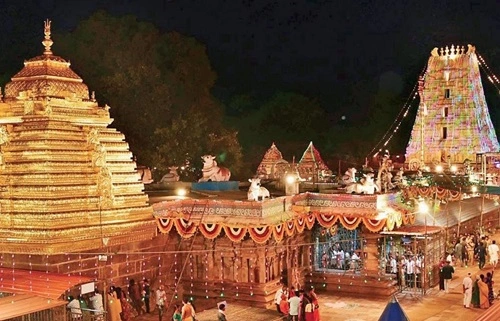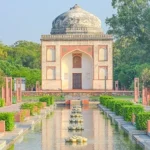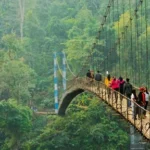Srisailam, a serene town situated in the Nallamala Hills of Andhra Pradesh, is one of India’s most revered pilgrimage sites. Nestled on the banks of the Krishna River, Srisailam is famous for the Mallikarjuna Jyotirlinga Temple, dedicated to Lord Shiva, and the Bhramaramba Devi Temple, devoted to Goddess Parvati. Known as one of the twelve Jyotirlingas and eighteen Shakti Peethas, Srisailam holds immense significance for devotees seeking divine blessings and spiritual solace. Along with its religious heritage, Srisailam boasts breathtaking natural beauty, with dense forests, scenic viewpoints, and cascading waterfalls that add to the town’s charm.
Planning the best time to visit Srisailam will enhance your experience, as each season brings a unique touch to this mystical destination. Here’s a guide to making the most of your visit to Srisailam, whether you’re drawn to the temples, natural landscapes, or simply the tranquil ambiance.

Exploring the Spiritual and Natural Beauty of Srisailam
Srisailam offers a blend of spiritual devotion and natural grandeur. The Mallikarjuna Temple is a revered destination for Hindus, attracting pilgrims from all over the country. Besides the temple, visitors can explore Srisailam Dam, the mesmerizing Pathala Ganga (a sacred spot on the Krishna River), and the rich wilderness of the Srisailam Tiger Reserve. From spirituality to adventure, Srisailam is a multifaceted destination that resonates with travelers of all kinds.
Best Seasons to Visit Srisailam
1. Winter (October to February)
Winter is widely considered the best season to visit Srisailam, as the weather is cool and pleasant, with temperatures ranging from 15°C to 25°C. This comfortable climate allows visitors to explore the temple complex, nearby attractions, and forest trails without the exhaustion that summer’s heat often brings. The misty mornings, clear skies, and mild afternoons make winter ideal for sightseeing and spiritual reflection.
During this time, the temples hold special rituals and prayers, adding to the spiritual ambiance. Festivals such as Maha Shivaratri, usually celebrated in February or March, draw large crowds to the Mallikarjuna Temple, where devotees gather to offer prayers and witness vibrant ceremonies in honor of Lord Shiva. If you’re interested in experiencing the energy of Srisailam during a major Hindu festival, planning your visit around Maha Shivaratri can be an unforgettable experience.
Additionally, the cooler climate makes winter an excellent time for outdoor activities like trekking and exploring the scenic viewpoints around Srisailam, such as Sikharam (the highest point in Srisailam) and the mesmerizing Pathala Ganga, where visitors can take boat rides on the Krishna River. The winter months are also perfect for visiting the Srisailam Dam, one of the largest dams in India, offering stunning views of the Krishna River and surrounding hills.
2. Monsoon (June to September)
The monsoon season brings moderate to heavy rainfall to Srisailam, creating a refreshing and vibrant atmosphere. The temperature during monsoon ranges from 20°C to 28°C, and the entire region comes alive with lush greenery, transforming the hills, valleys, and forests into a visual treat. The monsoon season enhances Srisailam’s natural beauty, and the mist-covered hills and roaring waterfalls make it an ideal time for nature lovers and photographers.
During the monsoon, waterfalls in and around Srisailam, such as Akkamahadevi Caves and Kadalivanam, are in full flow, offering breathtaking sights. Trekking through the rain-soaked forests is an adventure in itself, though visitors should be cautious on slippery paths. If you don’t mind the occasional downpour, monsoon provides a quieter, more intimate experience with nature.
The rain-washed temples and scenic viewpoints offer a serene setting for visitors seeking peace and introspection. However, it’s essential to carry rain gear and plan around potential road closures, as heavy rains can sometimes affect accessibility.
3. Summer (March to May)
Summer in Srisailam can be hot, with temperatures reaching as high as 40°C, making it less popular among tourists. However, early mornings and evenings are relatively cooler, allowing visitors to explore without discomfort. For those who prefer fewer crowds and a more peaceful pilgrimage experience, summer is a viable option. While the heat may be intense, the temple complex remains open, offering devotees a chance to seek blessings without long queues or crowds.
A unique aspect of visiting Srisailam in summer is the annual Brahmotsavam Festival, celebrated in April. This grand event attracts thousands of devotees and includes colorful processions, music, dance performances, and traditional rituals honoring Lord Mallikarjuna and Goddess Bhramaramba. If you plan to visit Srisailam during Brahmotsavam, it’s advisable to book accommodations in advance, as the festival brings a surge of visitors to the town.
For those willing to brave the heat, exploring Pathala Ganga in the early morning is a rewarding experience, as the quiet riverside setting offers a serene place for meditation and boat rides on the Krishna River. Additionally, Srisailam Dam and the tiger reserve can still be visited in the mornings and evenings, though visitors should come prepared for the higher temperatures.
Practical Tips for Visiting Srisailam
- Dress Code: Srisailam is a sacred destination, and visitors are expected to dress modestly, especially when visiting temples. Traditional attire is preferred, with men advised to wear dhotis and women to wear sarees or salwar suits.
- Temple Timings: The temple is open from early morning to evening, with specific hours for darshan. It’s best to visit during early morning hours for a peaceful experience.
- Accommodation: Srisailam has a range of accommodation options, from budget guesthouses to mid-range hotels. During festivals, it’s wise to book well in advance to secure a room.
- Local Cuisine: Srisailam offers traditional Andhra cuisine, with vegetarian options available near the temple complex. Don’t miss out on trying local specialties like pulihora (tamarind rice) and curd rice, commonly served in the temple’s free meals.
- Travel Precautions: Srisailam is located within a forest area, so visitors should be mindful of wildlife. When exploring the Srisailam Tiger Reserve or hiking in nearby forests, it’s essential to follow the guidelines provided by local authorities.
Conclusion
Srisailam is a destination that captivates visitors with its spiritual energy, scenic beauty, and cultural significance. Whether you’re attending vibrant festivals in winter, embracing nature’s bounty during monsoon, or seeking a quiet pilgrimage in summer, Srisailam offers a range of experiences throughout the year. Choose the season that aligns with your preferences and let the sacred aura of Srisailam inspire your journey to this ancient abode of divinity.


